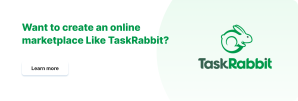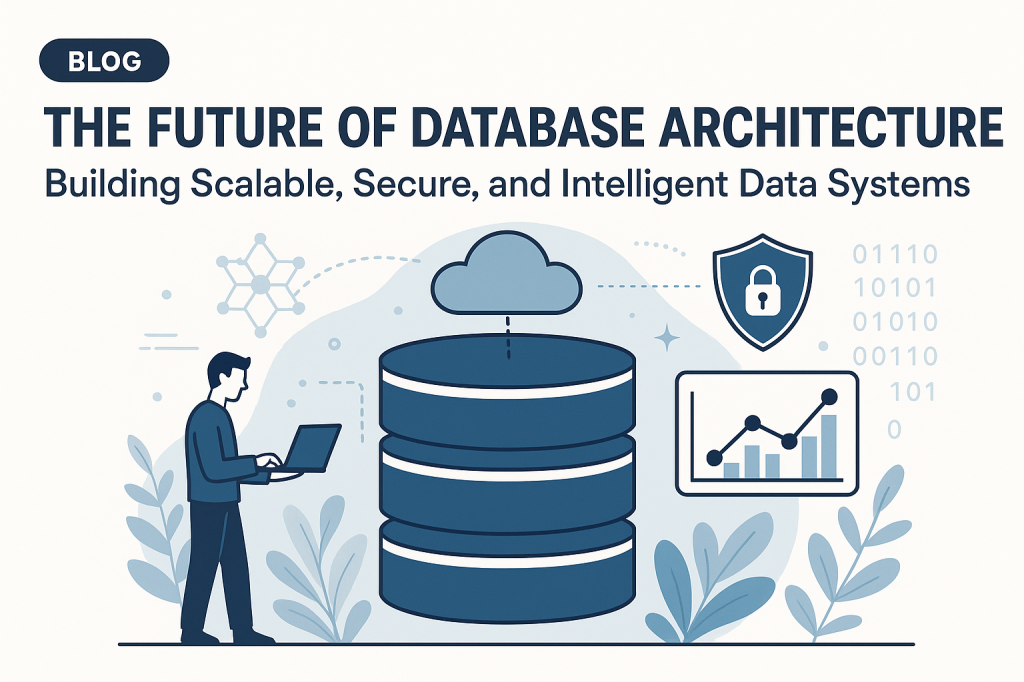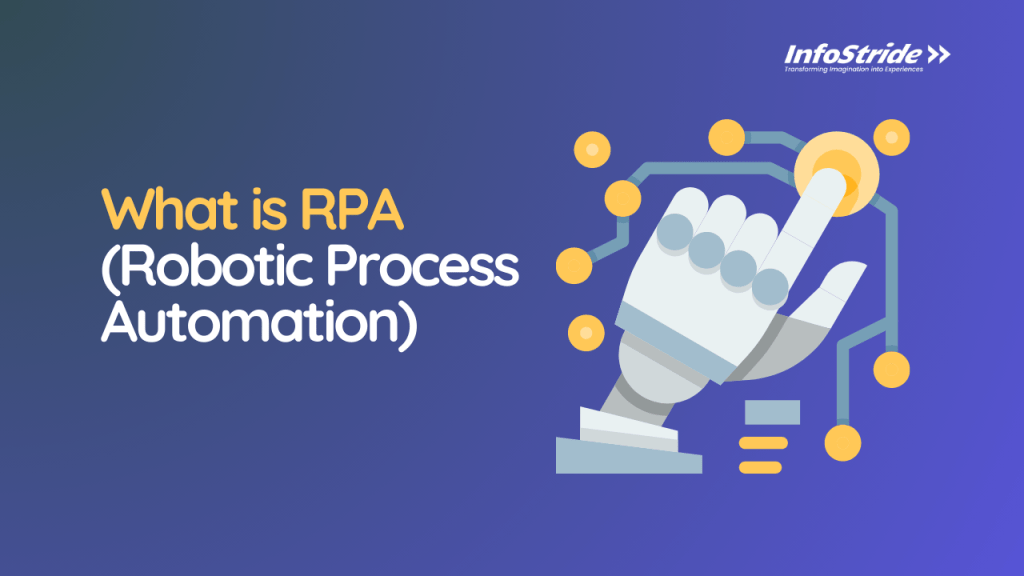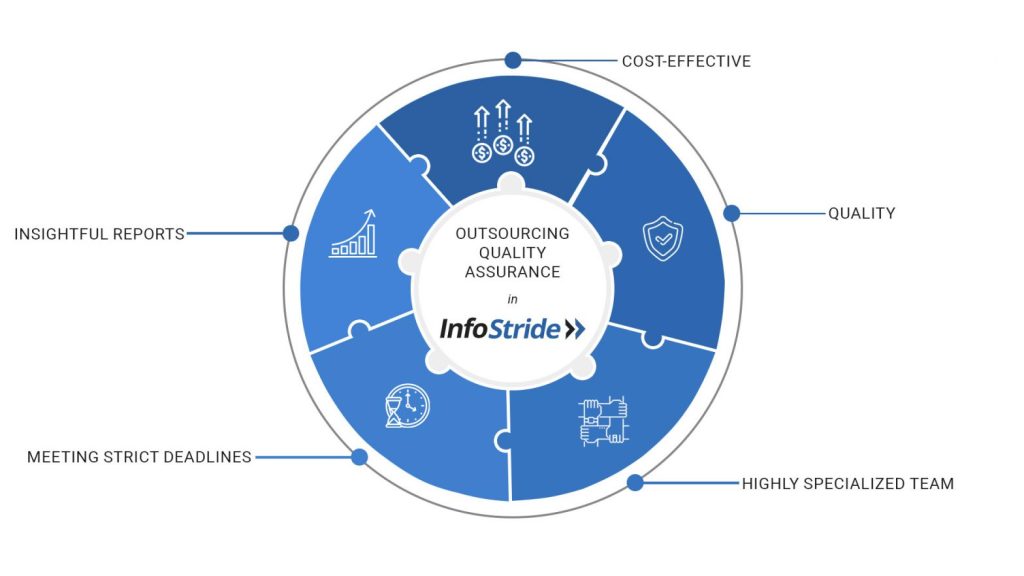As an increasing number of individuals opt for online shopping over conventional brick-and-mortar stores, e-commerce has witnessed an unmatched surge in popularity. Even a recent study found that approximately 79% of Americans shop online.
Thus, it’s no surprise to see that more aspiring entrepreneurs like you look forward to creating an online marketplace like Amazon and eBay.
In this guide, we will walk you through the steps on how to create an online marketplace. From creating a marketplace MVP to launching and growing your business, you’ll get to know everything to get started on your journey today.
What is an Online Marketplace?
An online marketplace is a digital platform where multiple third-party sellers can list and sell their products or services to a wide audience of potential buyers. It serves as a platform where buyers and sellers can connect, transact and exchange goods or services. Online marketplaces can vary in size and scope, from large global platforms like Amazon and eBay to smaller, niche-specific marketplaces like Etsy catering to specific product categories or industries.
Types of Online Marketplaces
Before you learn how to create an online marketplace, you should know that online marketplaces can be classified into different types based on a number of factors, including:
Based on the focus
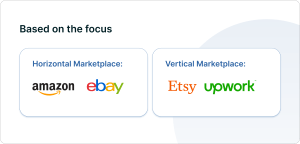
- Horizontal marketplaces: They offer a wide variety of products and services from different sellers. Examples include Amazon and eBay.
- Vertical marketplaces: They focus on a specific type of product or service. Examples include Etsy (handcrafted goods), Upwork (freelance services) and Udemy (online courses).
Based on the target audience
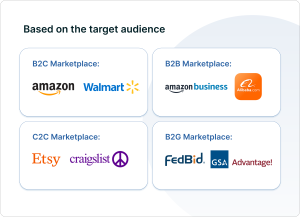
- B2C (business-to-consumer) marketplaces: B2C platforms connect businesses (sellers) directly to individual consumers (buyers). Examples include Amazon and Walmart.com.
- B2B (business-to-business) marketplaces: B2B marketplaces connect businesses with other businesses to buy and sell products and services. Examples include Amazon Business, Alibaba and Tradekey.
- C2C (consumer-to-consumer) marketplaces: C2C platforms enable individual consumers to buy and sell items or services to one another. Examples include Etsy, eBay and Craigslist.
- B2G (business-to-government) marketplaces: These platforms connect businesses with government agencies for procurement and contract opportunities. Examples include FedBid and GSA Advantage.
Based on the geographic reach
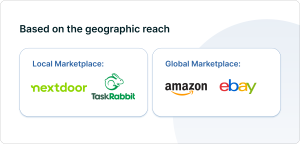
- Local marketplaces: Hyper-local platforms that connect buyers and sellers within specific geographic areas. Examples include Nextdoor and TaskRabbit.
- Global marketplaces: Online marketplaces with a global reach, catering to consumers and sellers from around the world. Examples include Amazon and eBay.
Key Benefits of Creating an Online Marketplace
Launching an online marketplace can offer numerous benefits for marketplace owners. Here are some potential benefits to expect:
Low operating costs
Compared to traditional brick-and-mortar businesses, online marketplaces often have lower overhead costs. There’s no need for physical stores or extensive inventory management since it is maintained by third-party sellers on the platform.
Multiple revenue streams
Online marketplace owners can generate revenue through various channels, such as transaction fees, subscription models, advertising, premium listings, premium memberships or partnerships with complementary services. This can lead to a consistent stream of income.
A scalable business
Online marketplaces are highly scalable businesses. As the marketplace grows and attracts more buyers and sellers, the marketplace owner’s revenue and user base can also grow significantly.
Global reach
Online marketplaces have the potential to reach a global audience, allowing small independent businesses to expand their customer base beyond local or regional boundaries.
User interest
Online marketplaces can offer a wide range of products or services, making them a one-stop destination for consumers. This variety attracts more users.
Investor interest
Multi-vendor online marketplaces have also captured the attention of investors. Their ability to align with changing consumer needs and its various revenue avenues have collectively ignited investor interest. Moreover, successful marketplaces may become attractive acquisition targets for larger companies or investors.
How to Create an Online Marketplace?
Creating an online marketplace involves several key steps. Let’s have a look at all the major steps to creating a multi-vendor e-commerce marketplace website.
Step 1: Choose your niche
When you plan to create a multi-vendor ecommerce marketplace website, the first step is to choose a niche. This is the type of products or services that your marketplace will focus on. It is important to choose a specific niche that you are passionate about or go with one where you see that the needs of modern customers are not met rather than competing with big players in the market such as Amazon.
When choosing a niche, you should also consider the following factors:
- Market size: How big is the market for the products or services that your marketplace will target?
- Competition: How much competition is there in this niche?
- Growth potential: Is this niche growing?
- Profitability: Is it possible to make a profit in this niche?
- Unique selling proposition: What will make your marketplace different from the competition?
Step 2: Research the market
Once you have decided on a niche you want to target for your online marketplace, the next step is to perform due market research. This includes validating your niche choice, understanding the competitive landscape, gathering insights about your target audience and knowing the latest trends in the industry.
- Competitive analysis: Study your competitors in the chosen niche. Analyze their strengths, weaknesses, pricing strategies and customer reviews.
- User Surveys and interviews: Conduct surveys or interviews with potential users to gather feedback on their expectations and pain points related to the niche.
- Market trends: Stay updated on industry trends and emerging technologies that could impact your marketplace.
Step 3: Define a business model
A sustainable business model is essential to monetize your marketplace effectively. Let’s see at the most common monetization strategies used by online marketplaces:
- Commission: The marketplace takes a commission on each sale that is made on the platform. The commission rate typically varies depending on the product or service being sold, but it is typically between 5% and 20%.
- Subscription fees: Marketplaces can offer premium subscription tiers with added benefits to both buyers and sellers. These subscriptions often come with features like priority listings, advanced analytics or reduced transaction fees.
- Listing fees: Some online marketplaces charge sellers a fee to list their products or services on the platform. Etsy, for instance, charges sellers a listing fee for each item they list in their shop.
- Advertising: Some online marketplaces sell advertising space to businesses that want to reach their target audience.
- Hybrid monetization: Some online marketplaces use a hybrid monetization strategy that combines multiple monetization strategies.
The best monetization strategy for an online marketplace will depend on a number of factors, including the niche of the marketplace, the target audience and the competitive landscape.
Step 4: Develop a marketplace MVP
MVP stands for Minimum Viable Product. It is a version of a product with just enough features to be usable by early customers who can then provide feedback for future product development. The MVP app development approach allows you to test your idea with real users and get feedback before you invest too much time and money into development.
Moreover, an MVP can be launched much more quickly than a fully-fledged product. This gives you a chance to get your product into the hands of users sooner and start generating revenue.
When embarking on the journey to create a multi-vendor ecommerce marketplace website, below are key considerations that must be taken into account:
Domain name
The domain name serves as your marketplace website’s online address, making it easy for users to find and access your platform (for example: amazon.com or infostride.com).
When choosing a domain name, consider the following tips:
- Aim for a concise and straightforward name that users can easily recall.
- Your domain name should reflect your marketplace’s brand identity and purpose.
- Ensure your domain name is distinctive and not easily confused with other websites.
- Avoid incorporating numbers or hyphens.
Web hosting
Web hosting provides the infrastructure and resources necessary to make websites and web applications accessible on the internet. It involves storing website files, databases, and other content on specialized computers known as servers. These servers are connected to the internet and configured to deliver web content to users’ browsers when they visit a website.
There are different types of web hosting, including shared hosting, virtual private server (VPS) hosting, dedicated server hosting, cloud hosting, and more.
When selecting web hosting for your online marketplace, carefully assess your current needs and consider future growth. It’s often a good idea to consult with your development team to determine the most suitable hosting solution for your specific marketplace requirements.
Content management system (CMS)
A content management system (CMS) is a software platform that facilitates the creation, management, and organization of digital content within the marketplace. It serves as the backbone of the marketplace, allowing administrators, sellers and users to efficiently manage and present content, such as product listings, descriptions, images, and more.
You can either build a CMS for your online marketplace from scratch or take advantage of MVP-friendly CMS software such as WordPress, Shopify, Joomla and others.
If you have a limited budget and a short timeline, using a CMS platform like WordPress or Shopify is often an ideal choice. The best option is to consider a hybrid approach, starting with an MVP-friendly CMS for a quicker launch and transitioning to a custom CMS as your marketplace matures and specific requirements emerge. This is a common approach for many businesses, as it allows them to get their marketplace up and running quickly and then make upgrades as needed.
Here are some key factors to consider when choosing CMS software for an online marketplace:
- Features: Make sure that the CMS software offers the features you need to launch your marketplace MVP. This includes features such as product management, customer management, payment processing, shipping & fulfillment, security, customer support, multilingual support, review & rating system and search & filtering.
- Scalability: Choose a CMS software that is scalable and can handle a large amount of traffic as your online marketplace grows.
- AI: Consider the AI features offered by the CMS software. Some CMS software offers built-in AI features such as AI-powered content creation, product recommendations and search, while others require you to integrate with third-party AI services.
- Customization: Look for a CMS that allows you to customize the design and functionality of your online marketplace to match your unique requirements. Customization is essential for creating a tailored user experience.
Step 5: Test and launch your marketplace
Once you have set up your marketplace MVP, it’s time to test and launch your marketplace to the public. Thorough quality assurance is critical to iron out any issues and ensure a seamless user experience. Also, perform beta testing with a select group of users to gain valuable feedback for further improvements. Once confident in the stability and functionality of your MVP, plan your marketplace’s launch. Consider a soft launch to gather initial user feedback and refine your offering.
Step 6: Grow your business
Once you have launched your marketplace MVP, you need to focus on growing your business and expanding your user base.
You can develop a comprehensive marketing strategy using digital marketing, social media and content marketing to attract both buyers and sellers. You can also partner with other businesses in your industry to cross-promote each other’s products and services.
It is important to track your progress and to make adjustments to your marketing strategy as needed. You should also continue to collect feedback from your users and improve your marketplace based on their feedback. After all, growing and creating an online marketplace is an ongoing journey that requires dedication, adaptability and a commitment to delivering value to both buyers and sellers on your platform.
How can InfoStride help you create a multi-vendor ecommerce marketplace website?
InfoStride is a trusted online marketplace development company. Our experienced developers can create a custom multi-vendor marketplace website tailored to your specific requirements. If you prefer to use an existing marketplace software as a foundation, we can help you choose the most suitable platform and customize it to meet your needs.
Our end-to-end marketplace development services range from intuitive design to development (B2B, B2C & C2C), multi-payment integration solutions and post-development support.
Irrespective of what your marketplace idea is, contact our experts to turn it into a reality today.
FAQs
1. How much does it cost to start a marketplace?
The cost to create a multi-vendor ecommerce marketplace website can vary widely depending on a number of factors, including the size and complexity of the marketplace, the features and functionality required, the development location, hosting costs and others. For a basic online marketplace with limited features, the startup costs could be as low as $10,000-$20,000. However, for a more complex marketplace with a wider range of features and functionality, the startup costs could be $100,000 or more.
2. What are the challenges of creating an online marketplace?
There are a number of challenges associated with creating an online marketplace, including:
- Customer acquisition: Attracting both buyers and sellers to your platform can be challenging, especially in the early stages. So, it’s a must to leverage digital marketing, content marketing, and social media to create awareness. Consider offering incentives or promotions to encourage initial sign-ups.
- Competition: There are many established online marketplaces, and it can be difficult to compete with them. You must differentiate your marketplace by offering unique features or a better user experience. Focus on a specific niche within your market to become a specialist in that area. Provide exceptional customer service to build trust and loyalty.
- Quality control: Maintaining the quality of products or services listed on your marketplace can be challenging, especially as you scale. Implement content moderation tools and policies to prevent spam, fraud and inappropriate content.
- Scaling: As your marketplace grows, scaling your platform to accommodate increased traffic and user demands can pose technical and operational challenges. Thus, invest in scalable infrastructure and technology from the beginning. Consider cloud computing solutions that can easily scale as needed.
- Regulatory compliance: Complying with legal and regulatory requirements, such as data protection and consumer rights, can be complex. Consider working with marketplace development experts like InfoStride who can help navigate the regulatory landscape.
3. Can I build a mobile app for my online marketplace?
Yes, you can build a mobile app for your online marketplace. In fact, having a dedicated mobile app can enhance user experience and reach a broader audience. Many successful marketplaces offer both web and mobile app versions to cater to users’ preferences. Work with a leading mobile app development company to build a user-friendly app.
4. What are some emerging trends in online marketplaces that I should be aware of?
Several emerging trends in online marketplaces include:
- Artificial Intelligence (AI): AI is being used for personalized recommendations, chatbots and fraud detection. For example, Amazon’s recommendation engine uses AI algorithms to suggest products to users based on their browsing and purchase history.
- Blockchain: Blockchain technology is enhancing security and transparency in transactions.
- Mobile Commerce: The shift toward mobile shopping and mobile payments is significant. The mobile apps of marketplaces like eBay and Airbnb have experienced significant adoption, making it easier for users to browse and transact on the go.
- Voice commerce: Voice commerce is the use of voice assistants to shop online. For example, Amazon’s Alexa can be used to shop for products on Amazon, demonstrating the potential of voice commerce.
- Augmented Reality (AR) and Virtual Reality (VR): AR and VR technologies are being integrated into online marketplaces to provide immersive shopping experiences and enhance product visualization. For example, IKEA’s AR app allows users to visualize furniture in their own space before making a purchase decision.
5. How do I convince investors to invest in my marketplace business?
Convincing investors to fund your marketplace business requires a well-prepared pitch. Here are some steps to consider:
- Solid business plan: Create a detailed business plan that outlines your marketplace’s value proposition, target market, monetization strategy and growth potential.
- MVP: Showcase your Minimum Viable Product (MVP) and any progress you’ve made. User traction or revenue, even in small amounts can be persuasive.
- Revenue model: Clearly explain your revenue model and how you plan to monetize the platform.
- Use of funds: Specify how you intend to use the investment funds and the expected ROI.
- Pitch presentation: Craft a compelling pitch presentation that tells a compelling story about your marketplace and why it’s a worthwhile investment.

